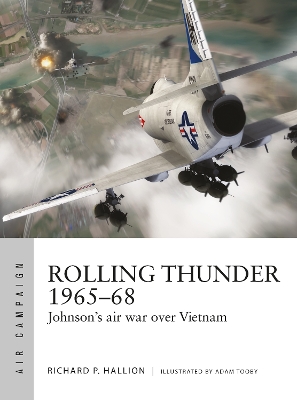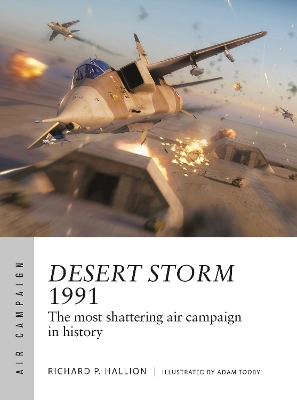Air Campaign
1 primary work • 2 total works
Book 3
Operation Rolling Thunder was the campaign that was meant to keep South Vietnam secure, and dissuade the North from arming and supplying the Viet Cong. It pitted the world's strongest air forces against the MiGs and missiles of a small Soviet client state. But the US airmen who flew Rolling Thunder missions were crippled by a badly thought-out strategy, rampant political interference in operational matters, and aircraft optimised for Cold War nuclear strikes rather than conventional warfare.
Ironically, Rolling Thunder was one of the most influential episodes of the Cold War - its failure spurring the 1970s US renaissance in professionalism, fighter design, and combat pilot training. Dr Richard P. Hallion, one of America's most eminent air power experts, explains how Rolling Thunder was conceived and fought, and why it became shorthand for how not to fight an air campaign.
Ironically, Rolling Thunder was one of the most influential episodes of the Cold War - its failure spurring the 1970s US renaissance in professionalism, fighter design, and combat pilot training. Dr Richard P. Hallion, one of America's most eminent air power experts, explains how Rolling Thunder was conceived and fought, and why it became shorthand for how not to fight an air campaign.
An expertly written, illustrated new analysis of the Desert Storm air campaign fought against Saddam Hussein's Iraq, which shattered the world's fourth-largest army and sixth-largest air force in just 39 days, and revolutionized the world's ideas about modern air power.
Operation Desert Storm took just over six weeks to destroy Saddam Hussein's war machine: a 39-day air campaign followed by a four-day ground assault. It shattered what had been the world's fourth-largest army and sixth-largest air force, and overturned conventional military assumptions about the effectiveness and value of air power.
In this book, Richard P. Hallion, one of the world's foremost experts on air warfare, explains why Desert Storm was a revolutionary victory, a war won with no single climatic battle. Instead, victory came thanks largely to a rigorously planned air campaign. It began with an opening night that smashed Iraq's advanced air defense system, and allowed systematic follow-on strikes to savage its military infrastructure and field capabilities. When the Coalition tanks finally rolled into Iraq, it was less an assault than an occupation.
The rapid victory in Desert Storm, which surprised many observers, led to widespread military reform as the world saw the new capabilities of precision air power, and it ushered in today's era of high-tech air warfare.
Operation Desert Storm took just over six weeks to destroy Saddam Hussein's war machine: a 39-day air campaign followed by a four-day ground assault. It shattered what had been the world's fourth-largest army and sixth-largest air force, and overturned conventional military assumptions about the effectiveness and value of air power.
In this book, Richard P. Hallion, one of the world's foremost experts on air warfare, explains why Desert Storm was a revolutionary victory, a war won with no single climatic battle. Instead, victory came thanks largely to a rigorously planned air campaign. It began with an opening night that smashed Iraq's advanced air defense system, and allowed systematic follow-on strikes to savage its military infrastructure and field capabilities. When the Coalition tanks finally rolled into Iraq, it was less an assault than an occupation.
The rapid victory in Desert Storm, which surprised many observers, led to widespread military reform as the world saw the new capabilities of precision air power, and it ushered in today's era of high-tech air warfare.

